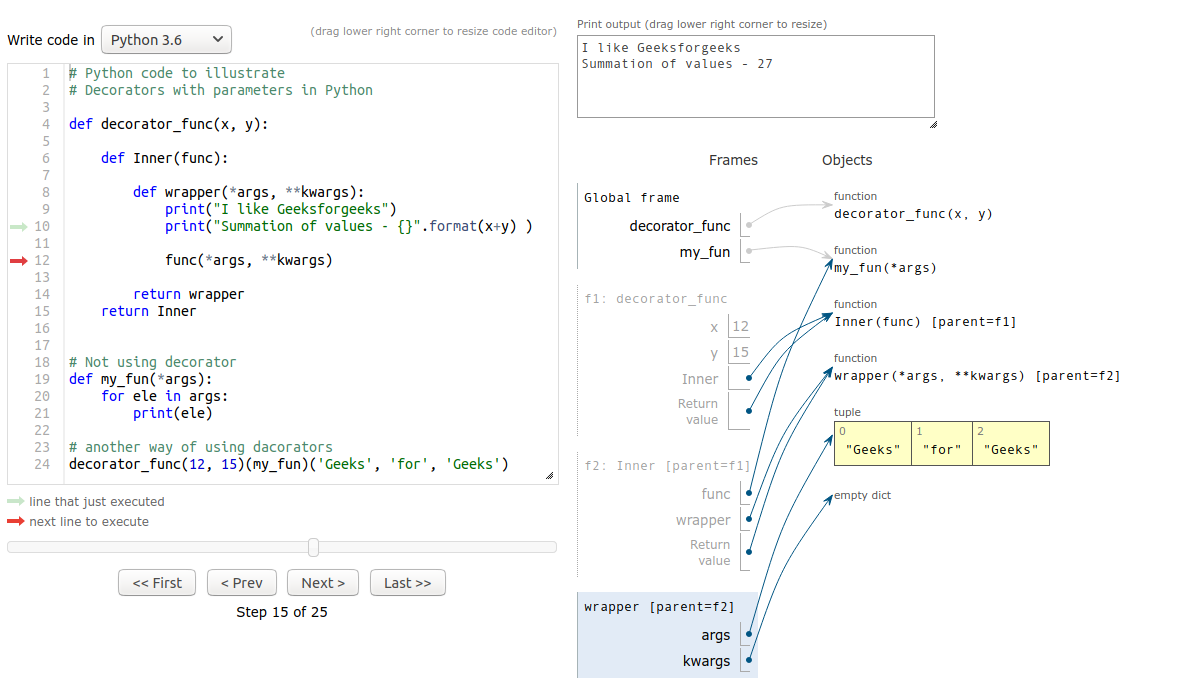Python中带参数的装饰器
先决条件: Python中的装饰器,函数装饰器
我们知道装饰器是Python中一个非常强大和有用的工具,因为它允许程序员修改函数或类的行为。在本文中,我们将了解 在多个示例的帮助下带有参数的装饰器。
Python函数是一等公民,这意味着函数可以像对待对象一样对待。
- 可以将函数分配给变量,即可以引用它们。
- 函数可以作为参数传递给另一个函数。
- 函数可以从函数返回。
带参数的装饰器类似于普通的装饰器。
带参数的装饰器的语法:
@decorator(params)
def func_name():
''' Function implementation'''上面的代码等价于
def func_name():
''' Function implementation'''
func_name = (decorator(params))(func_name)
"""当执行从左到右开始时, decorator(params)被调用,它返回一个函数对象fun_obj 。使用 fun_obj 调用fun_obj(fun_name) 。在内部函数内部,执行所需的操作并返回实际的函数引用,该引用将分配给func_name 。现在, func_name()可用于调用应用了装饰器的函数。
带参数的装饰器是如何实现的
Python3
def decorators(*args, **kwargs):
def inner(func):
'''
do operations with func
'''
return func
return inner #this is the fun_obj mentioned in the above content
@decorators(params)
def func():
"""
function implementation
"""Python3
# Python code to illustrate
# Decorators basic in Python
def decorator_fun(func):
print("Inside decorator")
def inner(*args, **kwargs):
print("Inside inner function")
print("Decorated the function")
# do operations with func
func()
return inner
@decorator_fun
def func_to():
print("Inside actual function")
func_to()Python3
# Python code to illustrate
# Decorators with parameters in Python
def decorator_fun(func):
print("Inside decorator")
def inner(*args, **kwargs):
print("Inside inner function")
print("Decorated the function")
func()
return inner
def func_to():
print("Inside actual function")
# another way of using decorators
decorator_fun(func_to)()Python3
# Python code to illustrate
# Decorators with parameters in Python
def decorator(*args, **kwargs):
print("Inside decorator")
def inner(func):
# code functionality here
print("Inside inner function")
print("I like", kwargs['like'])
func()
# returning inner function
return inner
@decorator(like = "geeksforgeeks")
def my_func():
print("Inside actual function")Python3
# Python code to illustrate
# Decorators with parameters in Python
def decorator_func(x, y):
def Inner(func):
def wrapper(*args, **kwargs):
print("I like Geeksforgeeks")
print("Summation of values - {}".format(x+y) )
func(*args, **kwargs)
return wrapper
return Inner
# Not using decorator
def my_fun(*args):
for ele in args:
print(ele)
# another way of using decorators
decorator_func(12, 15)(my_fun)('Geeks', 'for', 'Geeks')Python3
# Python code to illustrate
# Decorators with parameters in Python (Multi-level Decorators)
def decodecorator(dataType, message1, message2):
def decorator(fun):
print(message1)
def wrapper(*args, **kwargs):
print(message2)
if all([type(arg) == dataType for arg in args]):
return fun(*args, **kwargs)
return "Invalid Input"
return wrapper
return decorator
@decodecorator(str, "Decorator for 'stringJoin'", "stringJoin started ...")
def stringJoin(*args):
st = ''
for i in args:
st += i
return st
@decodecorator(int, "Decorator for 'summation'\n", "summation started ...")
def summation(*args):
summ = 0
for arg in args:
summ += arg
return summ
print(stringJoin("I ", 'like ', "Geeks", 'for', "geeks"))
print()
print(summation(19, 2, 8, 533, 67, 981, 119))这里的params也可以为空。
首先观察这些:
Python3
# Python code to illustrate
# Decorators basic in Python
def decorator_fun(func):
print("Inside decorator")
def inner(*args, **kwargs):
print("Inside inner function")
print("Decorated the function")
# do operations with func
func()
return inner
@decorator_fun
def func_to():
print("Inside actual function")
func_to()
其他方式:
Python3
# Python code to illustrate
# Decorators with parameters in Python
def decorator_fun(func):
print("Inside decorator")
def inner(*args, **kwargs):
print("Inside inner function")
print("Decorated the function")
func()
return inner
def func_to():
print("Inside actual function")
# another way of using decorators
decorator_fun(func_to)()
输出:
Inside decorator
Inside inner function
Decorated the function
Inside actual function
让我们来看另一个例子:
示例 #1:
Python3
# Python code to illustrate
# Decorators with parameters in Python
def decorator(*args, **kwargs):
print("Inside decorator")
def inner(func):
# code functionality here
print("Inside inner function")
print("I like", kwargs['like'])
func()
# returning inner function
return inner
@decorator(like = "geeksforgeeks")
def my_func():
print("Inside actual function")
输出:
Inside decorator
Inside inner function
I like geeksforgeeks
Inside actual function示例 #2:
Python3
# Python code to illustrate
# Decorators with parameters in Python
def decorator_func(x, y):
def Inner(func):
def wrapper(*args, **kwargs):
print("I like Geeksforgeeks")
print("Summation of values - {}".format(x+y) )
func(*args, **kwargs)
return wrapper
return Inner
# Not using decorator
def my_fun(*args):
for ele in args:
print(ele)
# another way of using decorators
decorator_func(12, 15)(my_fun)('Geeks', 'for', 'Geeks')
输出:
I like Geeksforgeeks
Summation of values - 27
Geeks
for
Geeks这个例子还告诉我们,外部函数参数可以被封闭的内部函数访问。
示例#3:
Python3
# Python code to illustrate
# Decorators with parameters in Python (Multi-level Decorators)
def decodecorator(dataType, message1, message2):
def decorator(fun):
print(message1)
def wrapper(*args, **kwargs):
print(message2)
if all([type(arg) == dataType for arg in args]):
return fun(*args, **kwargs)
return "Invalid Input"
return wrapper
return decorator
@decodecorator(str, "Decorator for 'stringJoin'", "stringJoin started ...")
def stringJoin(*args):
st = ''
for i in args:
st += i
return st
@decodecorator(int, "Decorator for 'summation'\n", "summation started ...")
def summation(*args):
summ = 0
for arg in args:
summ += arg
return summ
print(stringJoin("I ", 'like ', "Geeks", 'for', "geeks"))
print()
print(summation(19, 2, 8, 533, 67, 981, 119))
输出:
Decorator for 'stringJoin'
Decorator for 'summation'
stringJoin started ...
I like Geeksforgeeks
summation started ...
17291.装饰器内部

2.函数内部

注意:图像快照是使用 PythonTutor 拍摄的。